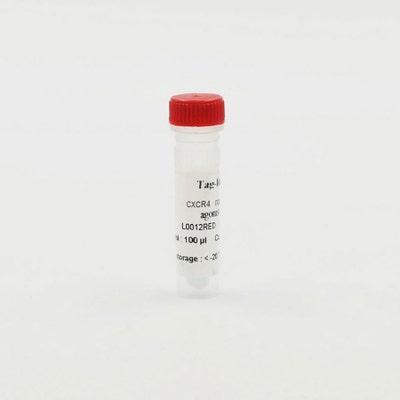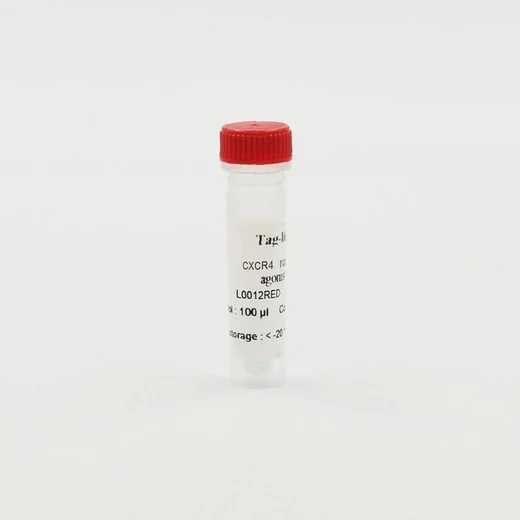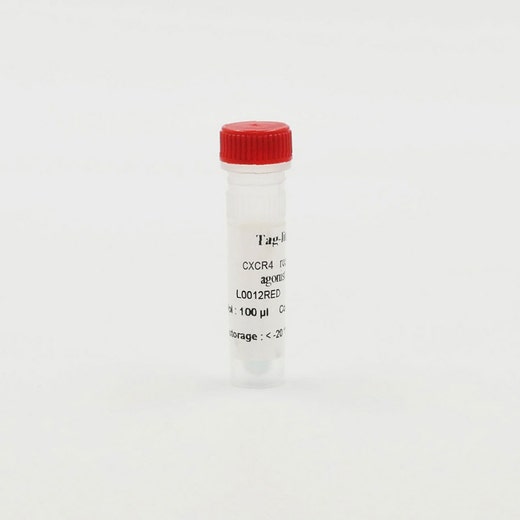

HTRF Tag-Lite CXCR4 Receptor Red Agonist Ligand, 5,000 Assay Points


HTRF Tag-Lite CXCR4 Receptor Red Agonist Ligand, 5,000 Assay Points






This CXCR4 receptor red agonist is a SDF1alpha derivative labeled with a red emitting HTRF fluorescent probe.
| Feature | Specification |
|---|---|
| Application | Receptor-Ligand Binding |
This CXCR4 receptor red agonist is a SDF1alpha derivative labeled with a red emitting HTRF fluorescent probe.



HTRF Tag-Lite CXCR4 Receptor Red Agonist Ligand, 5,000 Assay Points



HTRF Tag-Lite CXCR4 Receptor Red Agonist Ligand, 5,000 Assay Points



Product information
Overview
Tag-lite receptor binding assays use either a green or a red fluorescent ligand to function.
This CXCR4 receptor red agonist is a SDF1 alpha derivative labeled with a red emitting HTRF fluorescent probe.
This ligand is best suited for use in the Chemokine CXCR4 receptor binding assay.
Specifications
| Application |
Receptor-Ligand Binding
|
|---|---|
| Brand |
Tag-lite
|
| Detection Modality |
HTRF
|
| Product Group |
Fluorescent Reagent
|
| Shipping Conditions |
Shipped in Dry Ice
|
| Target Class |
GPCR
|
| Technology |
TR-FRET
|
| Therapeutic Area |
Cardiovascular
Infectious Diseases
Metabolism/Diabetes
NASH/Fibrosis
Neuroscience
Oncology & Inflammation
Rare Diseases
|
| Unit Size |
5,000 Assay Points
|
Video gallery

HTRF Tag-Lite CXCR4 Receptor Red Agonist Ligand, 5,000 Assay Points

HTRF Tag-Lite CXCR4 Receptor Red Agonist Ligand, 5,000 Assay Points

How it works
Assay principle
Running a receptor binding assay using Tag-lite is as easy as it can get. Simply dispense 10 µL of labeled cells into each well, followed by 5 µL of labeled ligand and 5 µL of the compound you wish to test. Like all HTRF assays, Tag-lite assays do not require any washing steps. A diagram of the procedure to be followed is given on the right.

Saturation binding (KD)
A saturation binding assay measures total and non-specific binding for increasing concentrations of ligand under equilibrium conditions. To perform the assay, the fluorescent ligand is titrated into a solution containing a fixed amount of labeled cells and then incubated to equilibrium. The HTRF ratio obtained from this titration is the total binding.


Competitive binding (KI)
A competitive binding assay is performed to measure the dissociation constant, Ki. To perform the assay, the compound is titrated into a solution containing a fixed concentration of fluorescent ligand and a fixed amount of cells.


Resources
Are you looking for resources, click on the resource type to explore further.
This guide provides you an overview of HTRF applications in several therapeutic areas.


How can we help you?
We are here to answer your questions.






























